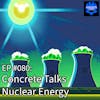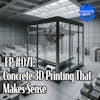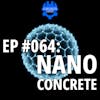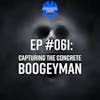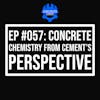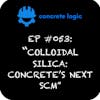EP #067: Maturity Meters - The Concrete Cylinder Breakup
Get ready for an illuminating episode of Concrete Logic! Our host Seth sits down with Mark Chase from RPX Technologies to delve into the world of maturity meters in construction. Discover the science behind these game-changers, and how they’re revolutionizing concrete construction!
Mark shares insider tips on how to use these tools to boost efficiency and hit project deadlines. Calibration and testing? We’ve got you covered. From post-tensioning to formwork removal, learn how maturity meters are making waves in the industry.
Key takeaways
- The magic of maturity meters: real-time strength of curing concrete.
- Calibration and testing: the secret sauce of accurate data.
- Maturity meters in action: post-tensioning, formwork removal, and mass concrete projects.
- Efficiency and timeliness: how maturity meters are making a difference.
- Practical tips: Marks' advice on different project scenarios.
Chapters
00:02 Introduction
00:46 How to support the show
2:29 Mark's Introduction
02:32 Maturity Meters
03:53 Appearance of Maturity Meters
05:28 Placement of Maturity Meters
06:59 Preparation and Calibration
09:27 Measurement and Projection
15:56 Efficiency and Project Schedule
20:04 Mass Concrete
20:57 Mass Concrete Applications
12:48 Data Accuracy and Testing
18:36 Using Maturity Meters
19:17 Advantages and Multiple Mix Designs
23:07 Conclusion
***
Did you learn something from this episode? If so, please consider donating to the show to help us continue to provide high-quality content for the concrete industry.
Donate here: https://www.concretelogicpodcast.com/support/
***
Episode References
Guest: Mark Chase | RPX Technologies | mchase@rpxtech.com Guest Website: https://construction.rpxtech.com/
Producers: Jodi Tandett, Olivia Stocker
Donate & Become a Producer: https://www.concretelogicpodcast.com/support/
Music: Mike Dunton | https://www.mikeduntonmusic.com | mikeduntonmusic@gmail.com | Instagram @Mike_Dunton
Host: Seth Tandett, seth@concretelogicpodcast.com
Host LinkedIn: https://www.linkedin.com/in/seth-tandett/
Website: https://www.concretelogicpodcast.com/
LinkedIn: https://www.linkedin.com/company/concrete-logic-podcast
Seth: [00:00:00] And welcome to another episode of the concrete logic podcast. And today I got a returning guest. It's a Mark Chase from RPX technologies. Mark did episode seven and we just recently. 66. So it's been a long time since Mark, and I caught up with each other. Mark's here to talk about maturity meters.
And we're going to talk about what those are and how we use those and get everybody. Back up to speed on that since it's been a long time since we talked about that subject, but before we get started, just a reminder, everybody how the podcast works. If you get any value out of this podcast, there's three things I ask or three options you can do to help the podcast.
So if you get some value out of this, think about these three things. One, share the podcast. So if Mark says something today and you're like, Hey that's pretty good idea. You can steal it from Mark [00:01:00] but the deal is yeah, you got to share it with somebody. Or if you go to our website, concretelogicpodcast.com and you go to the homepage and the bottom right hand corner of the page, you'll see a microphone. You can click on that microphone. And what it does is you talk into your computer, record a message, and it's like leaving me a voicemail and you can either ask a question or maybe suggest a guest. That would be very helpful. So that's another way you can help the podcast out. And then the third way is again on the homepage in the upper right hand corner, there's a button that says donate. And what you can do is click on that button and it will give you options to donate to the show.
And again, if you get any kind of value out of the podcast you got those three options and if you do decide to donate it's any amount you want to do, any amount is [00:02:00] appreciated and it just helps us keep going. So again, those three things share the podcast and then, you can get on the website and shoot me an idea on an episode or donate to the show.
Appreciate everybody's support. With that, Mark, we'll get started. Mark, you're in the maturity meter business, and you're an expert. That's why you're on this podcast. No pressure.
Mark Chase: Expert might be a stretch, but okay, I'll take it.
Seth: Can you explain the principle behind it?
What is, what are these meters? What do they do? And then we'll go from there.
Mark Chase: Sure. In essence, maturity meters are a way to determine real-time, strength, as concrete is cured, they are used in lieu of early construction cylinders that are taken. And in essence, you are taking a measurement of [00:03:00] time and temperature and comparing that against a standard for that mix design.
And out of it, you can get as I said, a real time strength number at any given time. So in, in terms of efficiency, it allows you to be proactive about those early construction activities as opposed to reactive as to what a cylinder break is going to tell you.
Seth: Right? Based on if you set it up, right?
The system, right? What you're saying is you can actually project the strength of the concrete based on what the temperature reading is when you're looking at, the well, let's talk about what they physically look like. So these meters, you actually stick into the concrete, right.
What does that look like?
Mark Chase: If anybody's old enough to remember what a 35 millimeter film canister look like. So it [00:04:00] essentially is it's just a small sensor that has a few things inside it. It's, it has its own power source, has its own battery. There is a microprocessor.
there's a thermistor, a way of gauging what the temperature is. And then that gets embedded in the concrete, sacrificed inside the concrete. And then there's a couple of wires coming out of the concrete. So that is how it looks. And then those two wires, they connect to a there's there has to be a way of getting the data from that sensor up to the cloud.
And that is through a couple of different ways. In our case, we have two different methods. There's a handheld reader. That you can use, or there is an autonomous way to where those two wires connect to a remote radio, which then through a process through an RF radio process, that information from the sensor gets automatically uploaded to the cloud.
Seth: Okay. [00:05:00] Yeah, so there's a, like a, an app maybe you can have on your phone and that'll tell you what the temperature is for that specific meter, right?
Correct.
Okay. And then as far as where we put these meters, is there, what, where do you put them in the concrete? Does it, do you tie them to the rebar?
Where would you put these things?
Mark Chase: If you are using these for maturity purposes or the real time strength purpose, then you would want to put them in the most conservative spot possible in your placement. And I'll give you an example. If you were doing a post tension deck you would want to place these in areas where it's going to be the coldest spot possible.
Because if that is up to strength or up to temperature, then everything else theoretically should already be there. So that in in most cases is going to be out towards the edge up towards the surface. [00:06:00] And then what people do is still if it's a wired sensor, they will run that wire up column rebar.
If there's a column out towards that area, just to get them out of the way to the finishers. But it's going to be in the least likely place to where concrete strength is going to be gained in the in the longest amount of time, right? In the shortest amount of time.
Seth: Okay. And so not. Listeners of this podcast know this and folks in the industry know this, but not all concrete is created equal, right?
So you can't just, this is not just like a plug and play kind of thing. You don't just put those meters out, you decide on, you're starting a job next week and you're pouring concrete and you get, you got some of these meters and you decide you want to put them in the pour and yeah, I'll tell you the temperature, but.
It's not going to tell you a whole lot more than that. Right, Mark? Because you gotta do some prep.
Mark Chase: [00:07:00] Yeah, there is a little bit of legwork that has to be done before. in, in, in best case scenario that you have to develop in essence, what is a heat of hydration curve of that mix design that you're going to use?
Or it's called a calibration curve. What that is. Entails is the sensor itself is not recording actual strength. It's recording a time and temperature measurement or a Celsius degree hour. What that's that Celsius degree hour, then we'll match up to a specific PSI.
in this beforehand work, there has to be some collaboration between the testing lab, maybe the ready-mix company if there's a concrete sub or a general contractor involved, there has to be a meeting that, so that everybody is in compliance or in agreement that this is the way that we're going to estimate our concrete strength. So at the outset, according to ASTM, there is a process of taking at least 17 cylinders per [00:08:00] mix design. 15 of those cylinders are going to be broken in sets of three at given intervals, say at one day, two day, three day, et cetera. The other two cylinders get sensors placed in them.
At the time that they break that first set of cylinders, they will be taking maturity readings off the two cylinders that have sensors in them, and that becomes the first point on the curve. And then you'll repeat that process until you run out of cylinders to break. So after you get done with that, then that curve has been established for that mix design.
Maturity is a mix specific operation. As I said, each mix design has its own unique heat of hydration curve that goes along with it. And what people can do in this case is they can be choosy as to which mix design that they're going to use based upon what kind of schedule that they have for this project. [00:09:00]
If they have a very rushed project or a timeline that they need to, that they need to conform to. Then they can choose a mixed design that maybe has something else in it that will make that concrete come up to strength faster. Or if they're not in that big a hurry, conversely, they can choose a mix design that has a little bit less of something in it that that allows that concrete to gain strength in a longer period of time.
Seth: So what you're doing is you're measuring temperature. In time and strength ahead of time before you start a project and you're breaking these cylinders and again, how much time it's been, what's the temperature of the concrete when you at the time you break it, right? Yes. And then the strength.
So you're recording those and then it, and you do it over a certain amount of time. And, like you said, 1 day, 3 days, 7 day, 28 [00:10:00] day. So based on that, that creates a, if you put that on a chart, it creates a curve. So you're able to see how the concrete gain strength over amount of time based on temperature and then knowing that information ahead of time, you can, when you're actually out on the project and you're actually pouring concrete and you have these meters in the concrete, you can, based on what the meters are reading, you can essentially project what that concrete strength is.
Right?
Mark Chase: That's correct. And the whole point of this thing is that the more massive concrete you have the more it's being affected by ambient conditions in the summertime, you're going to have hotter temperatures in, in the structure, as opposed to in a 6 by 12 or 4 by 8 cylinder. And everything is based on temperature.
So if you have elevated temperatures, the less time it's going to take for that concrete to cure [00:11:00] or reach those thresholds where you can start post tensioning or remove shoring, et cetera, et cetera.
Seth: Yeah. So remove. Yeah. That's the point or pull post tensioning. So PTs usually there's a certain amount of Strength that has to be gained in the concrete before you can pull P.T. that's why I've used it in the past. And like you said to shoring, there's requirements and specifications that say, hey, you gotta reach a certain strength before you can remove the shoring. So it would be useful for that as well. Because what we usually do. We break the actual cylinder. So you go wait for the third party inspector to break the cylinders to relay to everyone what those concrete breaks were, and then we can get into, all the moaning and groaning and complaining that we hear within the industry about how folks treat cylinders.
This is a way for you to maybe mitigate that [00:12:00] issue. And this technology Mark, we talked about this when you were on before, but it's been around for a long time. This is not something new, right?
Mark Chase: No. It's been around for decades and it's just within the advent of, micro technology that you've had the ability to place what essentially is a mini computer inside the concrete.
Seth: maybe people are thinking about this. They haven't used this technology before. So what we're saying is to use the maturity meters, you got to do this work ahead of time, ahead of the project. And you're taking cylinders. in A lab, right? And maybe at a ready mix suppliers facility.
And how are we making sure that the readings are going to be correct? How should we be treating those cylinders at the ready mix facility where we're taking these cylinders ahead of time?
Yeah, because we could treat those wrong and get bad data.
Right? And then this whole process is FUBAR.
Mark Chase: Sure. Well, for 1 thing any [00:13:00] cylinder that's taken on a construction site, whether you're using maturity sensors or not. Any cylinder really has to be treated according to what the ASTM for curing cylinders is, and I believe that's C31, in that for the first 24 hours, at least, they be they are contained in a temperature controlled environment.
To keep them between 60 and 80 degrees, when you're talking about creating a calibration curve, absolutely. You do want to have certain safeguards in that those cylinders aren't just sitting out the sun or sitting in a pile of snow. Typically, what happens is. Depending upon the actual project, sometimes a ready mix truck is sent over to the testing lab to where they'll take all 17 cylinders.
That way, there will be no issues with transporting cylinders at that to say, if your 1st interval break is a 24 hours there'll be [00:14:00] no issues with transporting those cylinders in that 1st, 24 hour period.
Seth: Every job that you want to do, Mark, everyone's on board, right? You go up and say, Hey, I got these maturity meters and they do this awesome thing.
So how does it, how for folks that haven't used it before, talk about your experience and how that all...
Mark Chase: sure, typically what happens if somebody is on the fence or like, say, a structural engineer or a general contractor or whoever it might be. What has to happen is that maturity meters are used, a calibration curve will be done, but at the outset of actually pouring concrete for the structure, both things will be done.
You'll place sensors in the, maturity sensors in the concrete, but you'll also take those field cured cylinders, maybe for the first one to the [00:15:00] 1st to 4th pour of the project so that then people can get an idea of what the difference is between taking a cylinder and taking measurements with a maturity sensor.
Yeah, there has to be some level of confidence in that you're getting accurate data from the maturity meters.
Seth: All right. And if you're thinking about using it too, I haven't been on a job yet or looked at a job yet that only has one mix design. So when you're thinking about this, you got to do it for each mix design, right, Mark?
Mark Chase: Yes, correct. Right. Like I said the whole premise of the concrete maturity is that it is mix specific. So each and every mix design has its own unique calibration curve.
Seth: All right. So I think we rehashed what it is, right? Is there anything else before we move on? You think we didn't cover just the basics of what the technology is and how it's used?
Mark Chase: I just want to get short, just a general point of using [00:16:00] maturity meters can make your operations more efficient. And in this day and age where just about every single project is on a fast track schedule this is 1 way to ensure that you keep on schedule with the concrete part of the project.
Seth: Yeah, I was thinking too, because we're going through a period here where we're using new materials, new cement, new fly ash. So there's a lot of testing going on right now anyways, so if you're getting into a new project that's using new mix designs based on maybe, I don't know, some, carbon footprint or global warming potential requirement you're going to have to be doing this testing anyways. If there's an opportunity to use maturity meters, and in, At the same time as testing these new concrete I think it's valuable data to have. I'm sure Mark will agree with me 'cause he's selling this stuff for a living, but that's [00:17:00] what's coming through my head right now is, hey we're gonna be doing a lot of testing with this, with these new materials anyway.
Mark, are there companies out there, ready mix companies, contractors out there that just do this as a standard? Like they've taken this data all the time- time, temperature, strength. Just as a standard that they do on every job.
Mark Chase: Yeah, I think a good way to answer that question is to tell you that when I 1st started doing this almost 18, 19 years ago I used to just chase tower cranes in whatever city I went to. And you come barging onto some, somebody's job site with something that looks like an M 80 firecracker, and you try to explain what the whole maturity process is.
So at that time maturity, even though it had been around for decades. Maturity was more state of the art technology to where now you have ready mix companies that, that keep a catalog of different calibration curves for those mixed [00:18:00] designs that they will generally propose to be used on certain projects.
In this day and age in some parts of the country maturity is more state of the industry now to where companies, and I'm not going to mention specific companies, but yours, for instance Baker will use this more often than not, because it gives them sometimes an advantage over competitors when it comes to bidding projects.
You can maybe get a project done sooner or get that concrete part of the project done sooner than say, somebody else.
Seth: But like you said, you shared earlier was, you got to get everybody on board with it. The structural engineers, they all got to be comfortable with it.
There's different ways you can do that. In the past I've broken cylinders the standard way, the traditional way along with the maturity meters and showed that the technology works. So you [00:19:00] can actually say, Hey, when we break that cylinder on that pour, we did last night, it's going to break at this before they break the cylinder, and then when they break the cylinder and it lines up, then you can say, see, it works. It works. Yeah, so you could do that to convince if you got some folks that are new to it.
Mark Chase: Yeah, and I should add with the technology of today you can more or less have your concrete talk to you in this autonomous world that we live in.
The sensors are continuously collecting data. That data is continuously being uploaded to the cloud, and then you can set your cloud software up to notify you once you reach certain thresholds or certain times that like strengths that you can start post tensioning. At 2 o'clock in the morning, you might get an email or text message saying that you're the concrete that you just poured the other day is ready to be ready to go.
Seth: you wanted to talk about a little bit about mass concrete too. Other than the post [00:20:00] tensioning and formwork applications, you were saying it used for mass concrete.
Mark Chase: Well, just in the past a little while here, maybe the past 2, 3, 4 years, mass concrete now has become more prevalent in that it's the definition according to is no longer just how big something is. It mass concrete is now defined as, uh, the geometric size, how big something is, and how much cement content is in the mix design. in theory, and there's a table out there that you can look at in theory, you could have something that's 6 inches deep, but you have um, A thousand pounds of cement in that mix design, that is enough cement to induce a lot of heat that could be deleterious to that concrete that you're pouring in that six inch slab.
Yeah, that's never going to happen, but [00:21:00] that's the worst case scenario in this table. So what mass concrete now has devolved into is that there used to be, and there still is specifications in mass concrete that, two things were historically looked at. One is the maximum temperature that element has gained as it's curing.
And I, I don't know where this originated from, but that number is like, say, 160 degrees or 165 degrees. People have tailored mix designs to keep that high temperature below 160 or 165. There is there's also another element which is called temperature differential in mass concrete.
And that's the difference between what's at the surface of the concrete and what's at the very middle. That number has historically been 35 degrees. There are ways to essentially keep the heat in to keep that differential down. Now what just in the [00:22:00] past little while uh, maturity has come into play in the fact that and it more has to deal with this differential thing that I was talking about.
In a mass concrete element there is a thing called a performance based temperature differential limit or PBDTL. In that some engineers now have a way of determining that when you first pour this mass element, your differential may be in the, 20 degrees, just making numbers up. But as that concrete gains strength, that differential limit then can rise.
And the whole point of it is, in a very general sense, the stronger concrete gets, the more resistant it's going to be to those thermal stresses being placed upon it. You have, you now have a way of determining. How strong that concrete is in real time and comparing that against this performance based temperature differential limit that has been created.
So [00:23:00] again, it is all about efficiency. It's all about knowing what's going on inside the concrete in real time.
Seth: so what you're if I'm hearing you right, so there's requirements out there for mass concrete, which mass concrete is just typically, it's a very large, pour. A big foundation or large column or something like that.
But you're saying now that there's a cement amount that may push you into mass concrete, even if it doesn't fit within those concrete size parameters And then, when you do, you get into some mass concrete, whatever, if it's defined as mass concrete, based on those two parameters, size or cement content, there is a requirement for the difference in temperature between the concrete poured in the ambient temperature?
Mark Chase: no, it's just so you're taking measurements inside the concrete. [00:24:00] So the worst case scenario, the coldest spot is going to be again, going to be up towards the surface out towards the corner, because that's where more heat is going to be lost in the initial period of caring.
And then the very center or geometric center of that element. you're taking the differential between the worst spots possible.
Seth: Gotcha. On the surface of the element, we'll just call it an element, and then the middle of it, so it's core. Yes. Okay. The difference between those two things, you got to keep them, uh, within a certain temperature difference between the two, based on the strength of the concrete.
there's a chart that tells you if it's going to be like 20 degrees or 40 degrees or whatever. Yeah. What a pain in the butt.
Someone figured out that creates a problem. So yeah, that I could see that that being used. So where do you see these jobs? [00:25:00] Is there a type of job that you see those requirements
Mark Chase: for mass concrete?
It goes across the board on commercial projects where mass concrete is involved.
It's something like a pile cap or a linear accelerator in a healthcare facility. And then all over the civil world, bridges, lock and dams, you name it. Naval facilities. Let's just throw that one out there. Just because I'm just talking to someone about that the other day... sporting stadiums.
Seth and I were just talking about the new Buffalo Bills Stadium, that's got a lot of mass concrete elements in it.
Seth: I was shocked. I was reading a spec the other day. It was a federal job, a base job, and it had maturity meter spec'd in it.
I had to read it twice. I was like, what? Because usually you think those are the last guys that Would jump on board.
Mark Chase: You have to share that info now.
Seth: Yeah. So that's great. Is there any other application other than [00:26:00] the mass concrete that you wanted to talk about?
So we talked about
post tension jobs. So there's a requirement before you pull the post tension cables. It's got to reach a certain strength. There are jobs where that don't have post tensioning or do have post tensioning that you're not allowed to remove form work till it reaches certain strength.
And now where we just talked about the mass concrete where you got to know the high temperature and the low temperature on a piece of concrete, and you got to make sure those the differences between those two things aren't beyond what is specified anything we missed?
Mark Chase: Yeah, just some secondary things that people sometimes don’t think about in colder weather, if like, say you're doing you're on the 16th floor of a high rise, and if you're in a colder climate I've seen it to where they'll tent that entire pour and then apply secondary heat [00:27:00] from the floor below.
These, those big jet engine heaters granted, it's not a big thing, but you can know when to turn those heaters off or when you can take the tenting down because once it reaches a certain strength, you don't necessarily have to keep heating it. So like I said, it's a small thing, but again it's just having that knowledge available to you that and in, in real time.
Seth: Yeah, all right. Is there anything else we need to cover?
Mark Chase: No, I think we've talked enough.
Seth: Okay. Well, Mark, I appreciate you coming on the show. If folks want to reach out to you and learn more about the maturity meter technology what's the best way to get a hold of you?
Mark Chase: Phone number is 314 713 1107.
And my email address is mchase, M C H A S E, at rpxtech, and that's T E C H dot com.
Seth: Okay, and we'll, as always, we'll put it in the show notes. So that's the, we'll put Mark's contact information on there. So you have it too. You don't have to write it down while you're listening to Mark, but all right, Mark, I appreciate you coming on the show today and folks until next time, keep it concrete.

Mark Chase
Nearly 20 years selling, educating, training, consulting, on sensor technology to the concrete construction industry, Markets include heavy civil, commercial, industrial, power generation, and petro chemical projects across the country.









